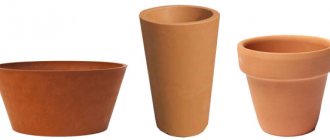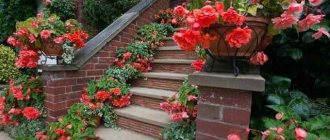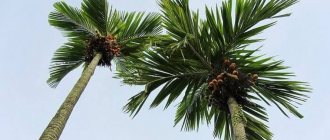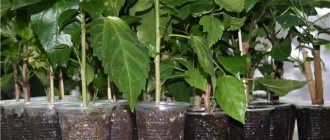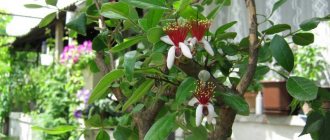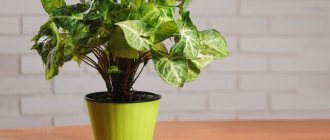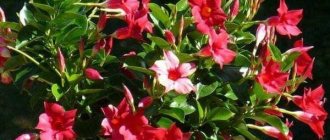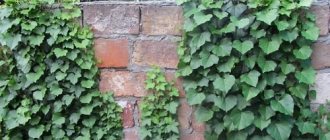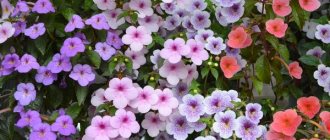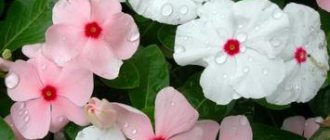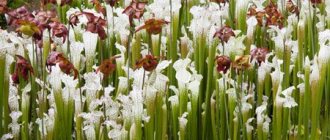Photo of chamaedorea in the interior In the collection of exotic house plants there will definitely be a palm tree such as chamaedorea. This is flowering perennial plant of the Palm family, numbering about 130 species. The homeland of Hamedorea is the tropics in East Africa, Central America, and Madagascar. Several species of this plant are found wild in the Crimea, the Caucasus, and southern Europe.
The most common are shrubby forms of this palm, but there are also chamedorea vines and plants with a single stem. It is characterized by slow growth - only 1-2 young leaves appear per year.
Male and female plants differ in flowers - in males they are red and yellow, collected in inflorescences, while in females they have single orange and bright red flowers.
Be sure to check out the similar Livistona palms and Trachycarpus Fortunea palms.
| It is characterized by slow growth - only 1-2 young leaves appear per year. |
| At home, the palm tree does not bloom. |
| The plant is easy to grow. Suitable for a beginner. |
| Perennial. |
Useful properties of chamedorea
Photo
Exotic palm tree has beneficial properties - it is phytoncidoactive. In other words, the plant is able to purify the air in the room and also effectively eliminates harmful fumes, for example, benzene, ammonia, formaldehyde and other volatile substances.
Hamedorea elegans. Photo
Features of growing at home. Briefly
Like any plant, chamedorea at home requires certain conditions of maintenance and care. Basic rules for growing palm trees:
| Temperature | 12-20˚С, does not tolerate too low and high temperatures. |
| Air humidity | About 50% is recommended, but tolerates low humidity. |
| Lighting | In summer, the soil should be constantly moist; in winter, watering should be reduced. |
| Watering | Regular, abundant after the top layer of soil dries out. |
| Palm soil | A substrate of 3 parts of turf soil and 1 part each of sand, peat, and deciduous soil. |
| Feeding and fertilizer | Universal fertilizer crushed in half with water is applied once every 2-4 weeks. |
| Transfer | Young plants require annual replanting, then every 3 years. |
| Reproduction | Seed method, suckers, dividing the bush. |
| Features of cultivation | Requires shading and frequent watering. |
Be sure to check out similar plants:
| Hamerops - cultivation and care |
| Livistona - care |
| Washingtonia |
| Yucca home - planting and care |
How does chamedorea reproduce?
Palm trees can be propagated in several ways: seed germination, cuttings, air layering.
Germination of seeds
Spathiphyllum Domino flower - home care
To propagate Hamedorea using this method, you must:
- Buy seeds.
- Place them in water and let them germinate for a week.
- Remove the top shell from them using sandpaper.
- Plant the seeds in small cups with fertilized soil and leave until spring.
Important! If the procedure is carried out in the autumn, the cups with shoots should be covered with plastic wrap.
Rooting cuttings
For reproduction you will need:
- In autumn, carefully inspect the palm tree.
- Carry out preventive spraying.
- Select strong and young cuttings and cut them.
- Place the shoots in water for several days, then plant them in soil fertilized with peat and send them to the basement or cellar.
In early spring, the plant can be planted in pots according to the standard scheme.
Propagation by cuttings
Air layering
To propagate a palm tree using this method you need:
- Examine the flower, select a straight and unbranched branch.
- Cut the bark along the ring.
- Place a plastic bag on the branch and secure it at the bottom with electrical tape.
- Pour fertilized soil into the bag and water it.
- Fertilize and water until March.
In early March, you will need to cut off the selected branch and transplant it into a separate pot.
Note! In some cases, the crop is propagated by bush division and root shoots. However, experts recommend giving preference to the cutting method.
Hamedorrhea: care at home. Details
In order for the palm tree to grow well, it is necessary to provide proper care for chamedorea in an apartment or house. Let's consider the features of growing this plant.
Bloom
The peculiarity of this palm tree is that it blooms already from the 3rd year.
If you plant several plants in a pot, they will bloom one by one throughout the year. Yellow delicate flowers with a pleasant aroma resemble mimosa. In young plants, it is recommended to remove the peduncle, since the plant spends a lot of energy and will not grow well. Feeding with fertilizer will correct the situation.
Temperature
It is especially sensitive to high temperatures, so in summer the room should be ventilated. In winter, the plant should be kept in a room with a temperature within 12-18°C, excluding drafts and hypothermia. But even in critical conditions the plant is able to survive.
Spraying
The optimal humidity for palm trees is about 50%. When growing a plant at home, it is recommended to spray it once a day with settled water. Some gardeners claim that the palm tree can be sprayed a couple of times a week, and in winter one spray per week is enough.
But even if the plant is not sprayed, it will not stop growing, but the likelihood of spider mite damage increases.
Lighting
The plant is considered one of the most shade-tolerant plants. It is best to place a pot with a palm tree near the eastern window. This is an ideal option for landscaping a room where there is little sunlight. If there is too much light, the leaves of the palm tree may turn yellow and the plant itself may weaken.
Hygiene
To keep the leaves clean, it is necessary to periodically shower the palm tree. If the plant is large, it is sprayed thoroughly.
Watering
This plant needs to be watered abundantly in summer, preventing the soil in the pot from drying out.
Homemade chamedorea is demanding on soil moisture, so it is watered 2-3 times a week. It should be remembered that overwatering is harmful for palm trees. In winter, the frequency of watering is reduced to once a week, which will avoid root rotting.
Pot
There is no clear opinion on choosing a pot: some recommend replanting the palm tree in a spacious container, while others believe that the pot should be cramped, so it needs to be replanted in a container with a slightly larger diameter.
Priming
The substrate consists of 3 parts - turf soil, which has a high density. Add 1 part of leaf soil, sand and peat to it. Soil acidity should be between 5-6.5.
It is recommended to use “Palma” from the prepared soil mixture, adding a little sand.
Feeding and fertilizer
In the summer, feed with universal fertilizer (for example, Agricola) once every 2-4 weeks. Only pre-fertilizing is diluted in half with water. In winter, there is no need to feed the palm tree.
Choose the right fertilizer for yourself !
Transfer
Young plants should be replanted every year into a larger diameter pot. An adult chamedorea is transplanted when roots become visible from the hole in the pot. That is, the procedure is carried out approximately once every 4-5 years. Since it is difficult for an adult palm tree to tolerate replanting, you can only renew the top layer of soil by replacing it with fresh substrate.
Pruning Hamedorea
If large brown spots appear on the leaves, such shoots should be trimmed. You also need to remove dry and yellowed leaves, cutting them down to living tissue. Pruning is carried out with sharp scissors, having previously treated them with alcohol. The cut sites are treated with a fungicide.
Some gardeners recommend removing flower stalks from young plants so that the palm tree grows well in the future.
Rest period
The basic rule for caring for a palm tree during the dormant period is no fertilizing, infrequent watering, and lowering the room temperature. The plant is rarely sprayed in winter.
Why does chamedorea dry out and the leaves turn yellow?
For some people, flowering does not occur as in the photo; on the contrary, the plant begins to dry out and turn yellow . Then the question arises, why the leaves dry out, what to do. When this occurs after a transplant, the phenomenon can be considered temporary. There is no need to worry if the lower leaves die off , as this is a natural process.
If there is massive drying out, one may suspect excessive dryness of the air. If the problem affects only the tips, then watering should be reduced . The same is recommended for limp plants with black leaves. Additionally, it is recommended to check the roots for rot.
Signs and superstitions are associated with chamedorea . People believe that a pot with a palm tree should not be brought into the apartment, otherwise disaster will happen. To avoid troubles, the plant should be started, for example, in a stroller. Naturally, all this is just superstition.
It is enough to see a palm tree bloom once to improve your mood . Small yellow flowers will create a summer atmosphere in the house and will delight the owner.
Growing from seeds
Fresh seeds are selected for sowing, since their germination rate decreases by 10% every month. That is, the seed packaging date should not be older than 10 months. If you have palm trees of both sexes growing in your house, you can manually pollinate the flowers and get your seeds.
Before planting, the seeds are soaked for 5-6 days, after removing the hard shell and filing it with a file or a grindstone. Each seed must be sown with the sawn part down in a separate cup into which the peat-sand mixture is poured.
There is no need to sprinkle the seed with soil; the cup is placed in a greenhouse to ensure a greenhouse effect. Periodically ventilate the shelter and moisten the soil. After 2 months, shoots will appear from homemade seeds, and from purchased ones - after 6-8 months. When the leaf grows to 4 cm, the seedlings can be transplanted.
Diseases and pests
Some problems may arise during cultivation:
- Dry tips of chamedorea leaves are a sign of dry air. It is necessary to regularly ventilate the room and spray the palm tree.
- Leaves turn yellow - too much light or watering with hard water. The plant should be moved to a darker place and soft water should be used.
- The leaves droop, die, and rot - this usually happens in winter due to rotting of the roots of the palm tree. The reason for this is excessive watering of the plant. To correct the situation, you need to reduce the frequency and volume of watering and loosen the soil. You can replant by cutting off the rotten roots, and adding drainage and moisture-retaining components (sphagnum or coal) to the soil.
- Brown spots on the leaves are a sign of overwatering the palm tree or using too hard water. It is necessary to cut off damaged leaves, reduce watering, and use soft water.
- The leaves wither and darken - the consequences of keeping them at low temperatures. You need to move the plant to a warmer room.
- The lower leaves fall off - this is a normal process for aging palm leaves. Such leaves are cut and the cut areas are treated.
- A cotton-like coating on the leaves is a sign of a mealybug appearing on the plant. The bush will need to be treated with insecticides.
Pests that can attack: mealybug, spider mite, scale insect.
Description
Chamaedorea is a genus of monocotyledonous flowering plants belonging to the palm family Arecaceae and numbering more than one hundred species. All chamedoreas are low-growing palm trees, widespread in South and Central America, naturally growing in the lower tier of foothill forests. Several species of chamedoreas are cultivated as indoor plants and, due to their unpretentiousness, are popular among gardeners. First of all, such species include high chamedorea (C. elatior), x. graceful (C. elegans), x. monochromatic (C. concolor) and some others.
Hamedorea in nature
Hamedorea is a true tropical palm. Of course, it is unlikely that you will be able to sunbathe under it due to its small size, but in all other respects it is no different from its tall relatives: the same bright green dissected leaves delight with their shade all year round.
Most palms have a single stem with a single growing point. They cannot be shortened, and when they reach the ceiling, they have to be disposed of. Hamedorea, on the other hand, is a bush palm that regularly produces new shoots. It has curved, feathery leaves, thin stems wrapped in the remains of petioles, reminiscent of a reed. And although each shoot has no more than four or five leaves, the palm tree looks truly luxurious due to the young growth.
Types of Hamedorea domestica with photos and names
The most common types are:
Chamaedorea elegans
This is a perennial single-stem plant up to 1.5-2 meters high. 6-7 feathery leaves develop on a smooth trunk. Each leaf is divided into 8-15 dark green, narrow-lanceolate segments. The inflorescence is loose panicles of cobs, which are formed by orange-red flowers. After flowering, black berries are formed.
Chamaedorea Ernesti-Augusti
This species has dark green leaves and is not divided into segments. The leaves are distinguished by a large wide plate, which is sometimes divided into two parts at the end. It grows slowly. The plant has a stem form - one stem grows from one rhizome. It blooms with red spherical flowers collected in spreading inflorescences.
Chamaedorea Elatior
The stems are tall, erect, and resemble bamboo stems in appearance. After the bottom leaf falls off, a light ring remains on the stem. The top of the stem is crowned with 4-6 dark green leaves of a pinnately dissected shape. The narrow lanceolate lobes have a pointed edge. It blooms with bright orange flowers collected in panicles.
Chamaedorea monochrome (lat. Chamaedorea Concolor)
The most unpretentious look. Shoots grow slowly, no higher than 1 meter in height. The plant form is bushy due to the formation of several thin shoots. At the top of the shoot there are light green leaves of a pinnately dissected shape. Flowering in this species occurs quickly - paniculate inflorescences of a yellowish tint appear on young plants.
Chamaedorea metallica (lat. Chamaedorea metallica)
This species is distinguished by the color of the leaves - they are dark green with a metallic tint. The leaves of the plant are solid, wide. Over time, the trunk becomes woody and thick. Plant height up to 2 meters (at home it grows lower). Shade-tolerant plant.
When and how does it bloom
In the wild, chamedorea blooms in the 3rd year of life in the warm season. In indoor conditions, flowering may occur later or not occur at all due to lack of lighting.
Note! Hybrids bred by breeders from wild forms of palm trees bloom more readily at home.
Types of flowers
Flowers are produced male and female. Because of this, owners of a single plant will not be able to obtain seeds at home.
Flower shapes
Multiple male flowers of red, yellow or orange hue are usually collected in paniculate or spicate (cob-like) inflorescences. Female flowers are solitary, bloom on a peduncle, have a similar color to male ones, and they have a bright aroma.
Flowering period
Flowering times can vary greatly depending on the variety and age of the plant. You should expect the appearance of buds from the second half of spring until September.
Changes in care during the flowering period
The buds of a plant in its third year should be removed to allow it to grow strong roots and foliage. In subsequent years, before flowering begins and after it ends, apply fertilizer and make sure that the soil remains slightly moist at all times.
Trimming
The formation of the crown of an indoor chamedorea palm tree is not required. As old leaves wither (the lifespan of each is 2 years or more), they are carefully removed to maintain the attractive appearance of the plant.
